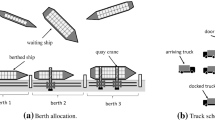Abstract
This paper deals with an unrelated machine scheduling problem of minimizing the total weighted flow time, subject to time-window job availability and machine downtime side constraints. We present a zero-one integer programming formulation of this problem. The linear programming relaxation of this formulation affords a tight lower bound and often generates an integer optimal solution for the problem. By exploiting the special structures inherent in the formulation, we develop some classes of strong valid inequalities that can be used to tighten the initial formulation, as well as to provide cutting planes in the context of a branch-and-cut procedure. A major computational bottleneck is the solution of the underlying linear programming relaxation because of the extremely high degree of degeneracy inherent in the formulation. In order to overcome this difficulty, we employ a Lagrangian dual formulation to generate lower and upper bounds and to drive the branch-and-bound algorithm. As a practical instance of the unrelated machine scheduling problem, we describe a combinatorial naval defense problem. This problem seeks to schedule a set of illuminators (passive homing devices) in order to strike a given set of targets using surface-to-air missiles in a naval battle-group engagement scenario. We present computational results for this problem using suitable realistic data.
Similar content being viewed by others
References
K.R. Baker,Introduction to Sequencing and Scheduling (Wiley, New York, 1974).
D.D. Boyer, E.L. Perry and E.L. Price, Force level control in naval anti-air warfare,Proc. Symp. on Command and Control Research, Naval Postgraduate School, Monterey, CA (June, 1990).
P.M. Camerini, L. Fratta and F. Maffioli, On improving relaxation methods by modified gradient techniques, Math. Progr. Study 3(1975)26–34.
T.J. Chan and C.A. Yano, A multiplier adjustment approach for the set partitioning problem, Oper. Res. 40(1992)S40-S47.
M.L. Fisher, The Lagrangian relaxation method for solving integer programming problems, Manag. Sci. 27(1981)1–18.
M.R. Garey and D.S. Johnson, Two-processor scheduling with start times and deadlines, SIAM J. Comp. 6(1977)416–426.
M.R. Garey and D.S. Johnson,Computers and Intractability: A Guide to the Theory of NP-Completeness (W.H. Freeman, New York, 1979).
E.S. Gottlieb and M.R. Rao, The generalized assignment problem: valid inequalities and facets, Math. Progr. 46(1990)31–52.
E.S. Gottlieb and M.R. Rao, (1,k)-configuration facets for the generalized assignment problem, Math. Progr. 46(1990)53–60.
J. Grabowski, E. Nowicki and S. Zdrzalka, A block approach for single machine schedule with release dates and due dates, Euro. J. Oper. Res. 26(1986)278–285.
P.L. Hammer, E.L. Johnson and U.N. Peled, Facets of regular 0–1 polytopes, Math. Progr. 8(1975)179–206.
M. Held, P. Wolfe and H.P. Crowder, Validation of subgradient optimization, Math. Progr. 6(1974)62–88.
Y. Lee, The polyhedral structure of some combinatorial optimization problems with applications to a naval defense problem, Ph.D. Dissertation, Department of Industrial and Systems Engineering, Virginia Polytechnic and State University (August, 1992).
V.J. Leon and S.D. Wu, On scheduling with ready-times, due-dates, and vacations, Naval Res. Log. 39(1992)53–65.
R.E. Marsten, An algorithm for large set partitioning problems, Manag. Sci. 20(1974)774–787.
G.L. Nemhauser and L.A. Wolsey,Integer and Combinatorial Optimization (Wiley, New York, 1988).
M. Padberg, On the facial structure of set packing polyhedra, Math. Progr. 5(1973)199–215.
M. Padberg and G. Rinaldi, A branch-and-cut algorithm for the resolution of large-scale symmetric traveling salesman problems, SIAM Rev. 33(1991)60–100.
C.N. Potts, Analysis of a heuristic for one machine sequencing with release dates and delivery times, Oper. Res. 28(1980)1436–1441.
S.C. Sarin, S. Ahn and A.B. Bishop, An improved branching scheme for the branch and bound procedure of schedulingn jobs onm parallel machines to minimize total weighted flowtime, Int. J. Prod. Res. 26(1988)1183–1191.
H.D. Sherali, Y. Lee and D.D. Boyer, Models and algorithms for scheduling passive homing device in battle-group anti-air warfare scenarios, Research Report, Department of Industrial and Systems engineering, Virginia Polytechnic Institute and State University, (Dec. 1991), to appear in Naval Res. Log.
H.D. Sherali and O. Ulular, A primal-dual conjugate subgradient algorithm for specially structured linear and convex programming problems, Appl. Math. Optim. 20(1989)193–224.
B. Simons, On scheduling with release times and deadlines, in:Proc. NATO Advanced Study and Research Institute on Theoretical Approach to Scheduling Problems, ed. M.A.H. Dempster et al. (Reidel, Hingham, 1981) pp. 75–88.
B. Simons, Multiprocessor scheduling of unit-time jobs with arbitrary release times and deadlines, SIAM J. Comp. 12(1983)294–299.
B. Simons and M.K. Warmuth, A fast algorithm for multiprocessor scheduling of unit-length jobs, SIAM J. Comp. 18(1989)690–710.
J.P. Sousa and L.A. Wolsey, A time index formulation on non-preemptive single machine scheduling problem, Math. Progr. 54(1992)353–367.
E. Zemel, Easily computable facets of the knapsack polytope, Math. Oper. Res. 14(1989)760–764.
Author information
Authors and Affiliations
Rights and permissions
About this article
Cite this article
Lee, Y., Sherali, H.D. Unrelated machine scheduling with time-window and machine downtime constraints: An application to a naval battle-group problem. Ann Oper Res 50, 339–365 (1994). https://doi.org/10.1007/BF02085647
Issue Date:
DOI: https://doi.org/10.1007/BF02085647




